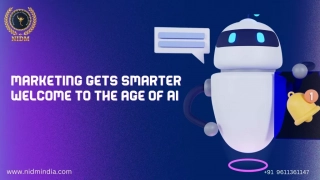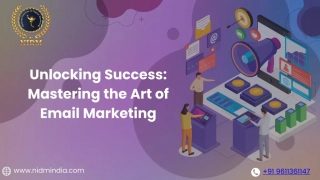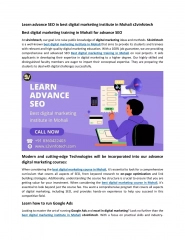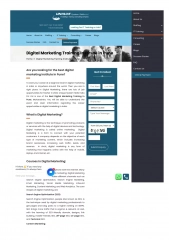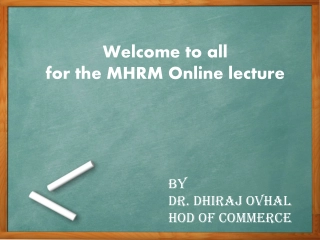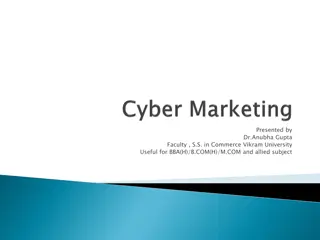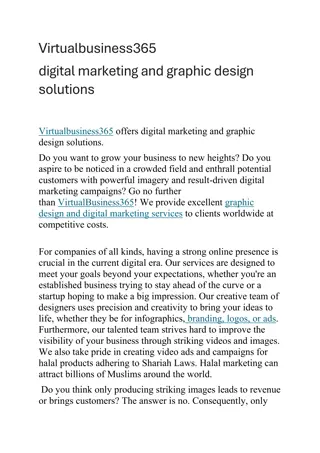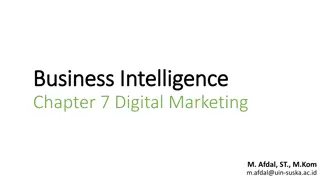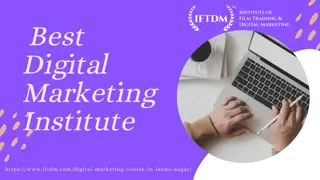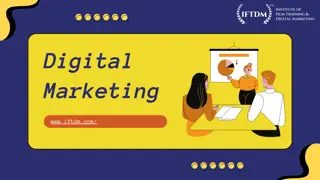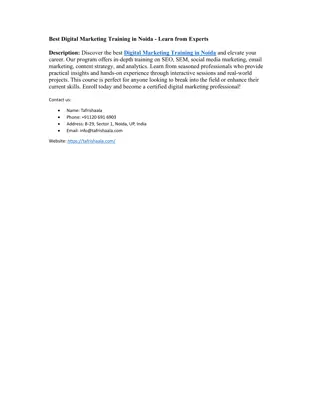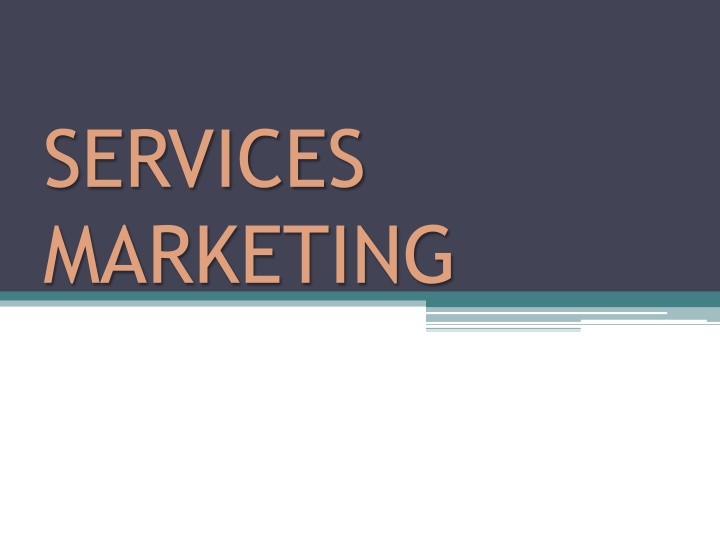
Services in Marketing and Business
Explore the concept of services in marketing and business, from the traditional to the modern views, examples of service industries, definitions of services by experts like Kotler and Bloom, and how services are defined on the tangible-intangible continuum. Learn how services play a crucial role in various industries and transactions.
Download Presentation

Please find below an Image/Link to download the presentation.
The content on the website is provided AS IS for your information and personal use only. It may not be sold, licensed, or shared on other websites without obtaining consent from the author. If you encounter any issues during the download, it is possible that the publisher has removed the file from their server.
You are allowed to download the files provided on this website for personal or commercial use, subject to the condition that they are used lawfully. All files are the property of their respective owners.
The content on the website is provided AS IS for your information and personal use only. It may not be sold, licensed, or shared on other websites without obtaining consent from the author.
E N D
Presentation Transcript
SERVICES MARKETING
WHAT IS A SERVICE? Services are deeds, efforts and performances. Services are everywhere, be it a travel and tourism destination or a doctor or a school or a meal at a restaurant. Earlier the perception of srevice was to work with only a service motto, without charging a fee but now it is not possible as the commercial viability of the organisation has to be secured.
What is Service? The Old View Service is a technical after-sale function that is provided by the service department. Old: Service = wrench time Old view of service = Customer Service Center
What is Service? The New View Service includes every interaction between any customer and anyone representing the company, including: Dealers Web site and any e-channel Interaction Salespeople Customer Billing and Accounting Personnel Receptionists and Schedulers Management and Executives Service Employees
Examples of Service Industries Health Care hospital, medical practice, dentistry, eye care Professional Services accounting, legal, architectural Financial Services banking, investment advising, insurance Hospitality restaurant, hotel/motel, bed & breakfast ski resort, rafting Travel airline, travel agency, theme park Others hair styling, pest control, plumbing, lawn maintenance, counseling services, health club, interior design
DEFINITION OF SERVICE Kotler and Bloom defined A service is any activity or benefit that one party can offer to another which is essentially intangible and does not result in the ownership of anything. Its production may or may not be tied to a physical product.
Services defined Most company offerings to customers contain an element of service and this is illustrated by the service continuum. Figure 15.1 The tangible intangible continuum for goods and services
Services defined Robert Judd defined services as a market transaction by an enterprise where the object of the market transaction is other than the transfer of a tangible commodity. Nowadays not only the traditional service industries are responsible for the growth of the service sector but other manufacturers are also turning towards the service aspects of their operations to generate additional revenue.
DIFFERENCE BETWEEN SERVICES AND GOODS Levitt proposed a distinction between the two by categorising them as follows:- Search goods (which can be packaged and seen, and evaluated before purchase) Experienced goods (which can be seen and evaluated after purchase) ...................contd.
Physical Goods Tangible Homogeneous Product and distribution separated from consumption A thing Core value produced in factory Customers do not participate in the production process Can be kept in stock Transfer of ownership Services S.No. 1. 2. 3. Intangible Heterogeneous Production, distribution and consumption are simultaneous process A activity Core value produced in buyer-seller interaction Customers participate in production 4. 5. 6. 7. 8. Cannot be kept in stock No transfer of ownership
Kotler classified product-service relation into four categories: 1. Pure tangible good. No service associated. 2. A tangible good with accompanying service. Eg. Refrigerator with warranty 3. A major service with accompanying minor service. Eg. railway(major service) offering food service(minor service). 4. Pure service. Eg. telecomm
Service characteristics Intangibility Inseparability Variability Perishability Lack of ownership
Intangibility Cannot be seen, tasted, felt, heard or smelt before they are bought. Eg. Sporting events, college education. Some of the aspects associated with services are tangible.
Implications of Intangibility Services cannot be inventoried Services cannot be easily patented Services cannot be readily displayed or communicated Pricing is difficult
How to reduce intangibility Stressing tangible clues Use of personal sources of information- stimulating word-of-mouth communication Creating a strong corporate image Encouraging employees to communicate with customers
Inseparability Services produced and consumed simultaneously. Cannot be separated from providers, whether people or machines. Customers are always involved Quality of service is depended on the ability of the service provider and interaction between service provider and the customer.
Implications of Simultaneous Production and Consumption Customers participate in and affect the transaction. Eg. Hair salon. Customer has a direct impact on the type and length of service delivery. Customers affect each other. Eg. Restaurants Employees affect the service outcome. Eg. Medical services Decentralization may be essential Mass production is difficult
How to reduce inseparability By selecting and training the public contact personnel to improve their skills in reliability, responsiveness, empathy and assurance Consumer management. Eg. Restaurant delivery services. Use of multi site locations By automating the services to reduce the dependence. Eg. ATM s
Variability/Heterogeneity It is variation in consistency from one service transaction to the next. Quality may vary greatly depending on who provides the service, when and how. This feature makes it impossible for a service operation to achieve 100 percent. Staff need to know how to do something well. Staff must be well motivated to maintain high standards of service.
Implications of Heterogeneity Service delivery and customer satisfaction depend on employee and customer actions Service quality depends on many uncontrollable factors. Service standardisation and quality control are difficult to achieve. There is no sure knowledge that the service delivered matches what was planned and promoted Customer may be dissatisfied because of bad quality
How to reduce heterogeneity Customisation- It develops services that meet each customer s individual needs. Provider can charge high margins. But the disadvantage is that the speed of delivery slows down. Eg. Stitching services Standardisation- This is to produce consistent service product from one transaction to the next.Eg. ATM . But it may give a message to customer that firm doesn t care about individual needs
Perishability Services cannot be stored for later sale or use. Eg. Flight with vacant seats The unused capacity can t be reserved and inventoried. Eg. Doctor s appointment.
Implications of Perishability It is difficult to synchronize supply and demand with services. Demand is unpredictable Services cannot be returned or resold Customer waits Overcrowding Loss of revenue
How to reduce perishability Creative Pricing Reservation system Development of complementary services Development of non-peak demand- to utilise the service downtime to prepare for peak time Part time employee utilisation Capacity sharing. Eg. Surgery units and pathology labs Advance preparation for expansion Utilisation of third parties. eg,. Travel agencies Increase in customer participation. Eg. Self service at McDonalds, ATM
Lack of ownership No physical product is exchanged and therefore nothing owned.
Challenges for Services Defining and improving quality Ensuring the delivery of consistent quality Designing and testing new services Communicating and maintaining a consistent image Accommodating fluctuating demand Motivating and sustaining employee commitment Coordinating marketing, operations, and human resource efforts Setting prices Finding a balance between standardization versus customization
GROWTH OF SERVICE SECTOR Growth has meant an increase not only in the overall volume of services but in variety and diversity of services offered. The reasons are as follows: Upward trend in the disposable income Growing specialisation Changes in culture and society Sophistication and competition in the market Globalisation which is contracting the communication gap ......contd.
....contd Advances in product technology Age of information and entertainment More women in workforce Demographic changes
IMPORTANCE OF SERVICE SECTOR Services are used widely in all aspects of life. The economies of developed countries are dominated by services. The inclusion of services in trade negotiation has led to GATS(General Agreement on Trade in Services). The service sector contributes more than half of Indian national income. Service sector is giving best jobs, best incomes and best talents. The growth in service sector has also been acknowledged by the stock market as BSE has given it a dominant place in it s 30-share index. ............contd.
..........contd. The growth in services has given way to service tax which covers a number of well known services like transportation of goods, travel agencies, consulting engineers, manpower recruitment agencies, etc. Service tax is an important tool for revenue collection. 83 % of total revenue is from following 5 sectors: Telecom services Insurance sector Advertising agencies Courier services Stock brokers
IMPORTANCE OF SERVICE SECTOR Generation and expansion iof job oppurtunities Paving avenues for capital formation To improve the national socio-economic condition To reduce dependence on sophisticated technologies Raising the standard of living Contribution to GDP Tranforms the internal and external values of human resources
CLASSIFICATION OF SERVICES It is useful as it provides better understanding of a particular service and difference between the service and other services. It s advantage over the past schemes are: It is comprehensive and incorporates the earlier classification schemes. It follows systematic order and allows classification of services based on common characteristics. It also assists in the development of marketing strategies and tactics for groups of services with common characteristics.
LEVELS OF CLASSIFICATION NATURE OF ORGANISATION CATEGORY OPTIONS Purpose (satisfy the needs of) Individuals Business Both Structure Profit Non-profit Public Private Type
NATURE OF THE SERVICE CATEGORY OPTIONS Degree of tradability Embodied Service Pure Service Individuals Things High Medium Low Service directed towards Degree of merchantability Tradability is the relative involvement between goods and services in the production of the service. Merchantability is the relative distance between the customer and the service provider in the acquisition or performance of the service.
CUSTOMER RELATIONSHIPS CATEGORY OPTIONS Type of relationship Formal Informal Both Customer must be present Customer must start and finish the service Customer has to start Customer has to finish Degree of participation
NATURE OF DEMAND CATEGORY OPTIONS Level of demand Demand exceeds capacity Sometimes demand exceeds capacity Demand does not exceed capacity Degree of fluctuation Wide Narrow Variable No Fluctuation
SERVICE PACKAGE CATEGORY No. of goods and services OPTIONS One service One service, one good One service, multiple goods Multiple services Multiple services, one good Multiple services, multiple goods Defined by situation Defined by time Both High Medium Low High Medium Low High Medium Low Units of Service Degree of Equipment base Degree of Customisation Degree of Durability
DELIVERY METHOD CATEGORY Availability of service OPTIONS One site Multiple sites Continuous Discrete Both Independent Collective Both Reservation Order-of-arrival Preferential Reservation and order-of- arrival Reservation and Preferential Order-of-arrival and preferential Reservation, order-of- arrival and preferential Nature of Delivery Type of Consumption Allocation of capacity
MARKETING MIX IN SERVICES The core of marketing is considered to be the marketing mix. This term was first introduced by Prof. Neil H. Borden of the Harvard Business School. Different mixes can be designed by the marketers to fight the competition. It is a set of marketing tools for a firm to pursue its marketing objectives. Mc Carthy clarified that customer is not a part of marketing mix rather he is the target of all the marketing efforts.
IMPORTANCE OF MARKETING MIX The services marketing mix comstitutes the variables, service firms can manage in order to produce sales and profit. These variables can be used to differentiate a firm from its competitors and to build a competitive advantage. This mix helps to achieve the corporate goals. But it was observed that 4 P s of marketing mix have certain limitations in the case of services. So, Judd came out with another P-People and Mc Grarth added two more-Physical facilities and process Management. .......contd.
.....contd To serve the customers better, service organisation have to identify an appropriate target market segment, identify the services that satisfy the segment s needs , they have to position themselves in the market place in relation to their competitors and they have to promote their services effectively.
SUCCESS FACTORS FOR SERVICE ORGANISATIONS Clear positioning strategy Outlining the elements of the product package Emphasis on quality Customer Retention Capturing and using customer data Close interaction among marketing operations and human resources Soliciting Feedback from customers and employees Top management Commitment
THE FIRST P :SERVICE PRODUCT OR PACKAGE Product is anything which is offered to the market for exchange or consumption. Kotler has identified 5 levels of a product: 1. CORE BENEFIT: It is the fundamental benefit that the customer is buying. Eg. In hotel, rest is the core benefit. 2. BASIC SERVICE: These are the basic and functional features of a service which consumers assume to be present. Eg. In hotel, bed and bathroom is the basic service.
3. EXPECTED SERVICE: It is the set of attributes/conditions, the buyer normally expects. Eg. Clean room, towel, silence. 4. AUGMENTED SERVICE: These meet the customer s desires beyond expectations and it helps to differentiate the service from the competitors. Eg. In hotel, music, prompt room service, etc. 5. POTENTIAL SERVICE: At t is level, firm tries to delight the customer. It also includes the futuristic product developments. Eg. A hotel initially into boarding and lodging may expand itself into resort and provide sight seeing tours.
WAYS TO DIFFERENTIATE THE SERVICE The holistic model of augmented service can help to differentiate the service. The following elements can be included: Number and skills of personnel Working hours and time used in performing various tasks Location of service outlet Infrastructure and documentation Interactive communication between employees and customers
Interactions with the physical and technical resources needed in the service process How well the customer is aware about the process of service delivery and his/ her role . How well is the customer prepared to share information How well is the customer willing to use the service equipment
DEVELOPING NEW SERVICE OFFERING It involves five steps: CONSUMER BENEFIT CONCEPT: It is to assess the benefits a customer is seeking SERVICE CONCEPT: in this the consumer benefits have to be differentiated so as to define what benefits the firm would offer SERVICE OFFER: In this the service elements, service forms, service levels and quantity has to be defined. SERVICE DELIVERY SYSTEM: In this the processes, people and facilities have to be developed so as to delivery right quality of service. MANAGING IMAGE AND COMMUNICATION: It is done to support and enhance the image of service offering.
THE SECOND P : PRICING This element relates to the acceptance and quality of a service. It reflects the value attached to the service by the service provider and correspond with the customer s perception. This component also determines the revenue of the firm. Different methods of pricing are followed by different firms depending upon the following objectives: .....................contd.
.........contd. 1. Planned market position for the service product as price affects the market position as well as the customer s positioning. 2. Stage of the life cycle of the service product. Eg. When no competition-charge high price, when tough competition then low price. 3. The competitive situation should be studied from the view of inter-brand and service providing same satisfaction. Eg. One airline has to compete with another airline as well as good railway service on the same route. 4. What is the role of pricing in the overall marketing strategy?
GUIDELINES FOR SERVICE PRICING I. The pricing strategy should be such, that can handle demand fluctuations successfully. II. Services prices should be based on costs so as to take into account the costs of tangible clues. III.Service pricing should provide value addition and quality indication to the customers IV. Pricing strategy should be such as to cope up with the degree of conpetition.


